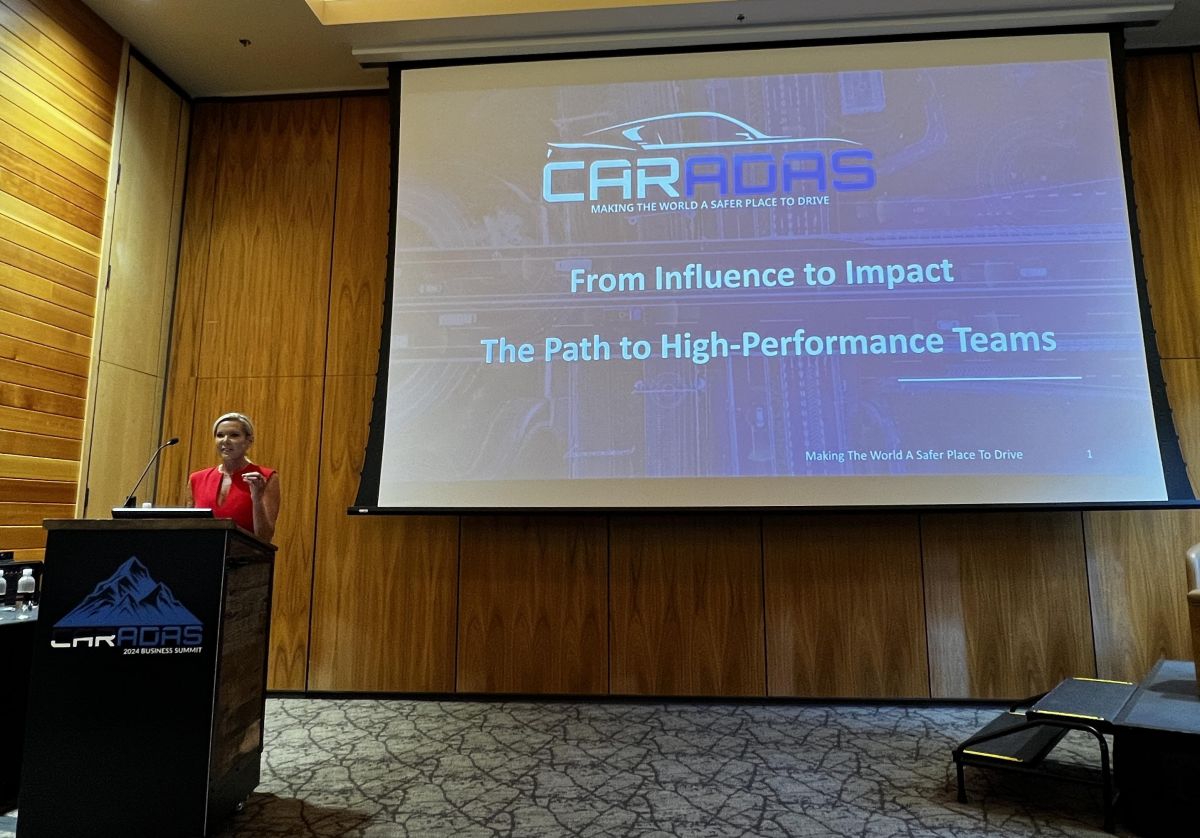There’s a common misconception many business leaders have, according to Collision Advice Coach Sheryl Driggers: to influence someone, you have to be in control of them.
“What I learned over the years is that the more you try to control people, the less influence you have,” said Driggers, a certified coach and trainer for John Maxwell's organization, Maxwell Leadership, and a Maxwell certified behavior analysis trainer.
Over her career, Driggers has shared the stage with best-selling author Chris Voss and is a contributing author to Voss’s latest book, "Influence and Impact.” Her chapter focuses on the four pillars she recommends to build high-performing teams: Inner Work, Outer Impact; Know and Grow Your Team; Unify & Clarify; and Persevere with Purpose.
During the Car ADAS Solutions Business Owners’ Summit in August, Driggers talked about the four pillars in her presentation, “From Influence to Impact: The Path to High-Performance Teams.” She provided insight on how to become a leader people want to follow and the importance of building leaders within the organization.
As the co-owner of a Tallahassee-based collision center that grew to include three locations and was later sold, Driggers said she spent many years with the mindset of “I'm the boss; you're the employee.”
“We did not get consistent results from that type of leadership,” she said.
Driggers found it can lead to burnout because of the weight on the leader's shoulders trying to control and do everything. “When owners and managers engage and start developing team members and providing resources to help them grow, they become engaged,” she said.
Otherwise, Driggers said, businesses end up with disengaged employees who can drain the business of its life and energy.
She cited a Gallup research study that indicated companies with a highly engaged workforce outperform peers by 147% in earnings per share.
Driggers said that building high-performance teams is more than aligning and assembling talented people. “Just as much as we want the best for our kids, we should want the best for our team members,” she said.
Inner Work, Outer Impact
Driggers noted the range of toxic leadership styles and said whatever is inside each of us will inevitably manifest itself externally.
“Have you ever worked with someone who was a perfectionist and demanded perfection, even though that's not a reality?” she pointed out. “Or someone with anger issues or who doesn’t like conflict?”
When leading from those mindsets, Driggers said leaders don't produce high-performing teams.
“We have to do the hard work to become the person people want to follow,” she emphasized.
Driggers explained that outer impact means cultivating self-awareness when you start seeing yourself through the lens of other people.
She recalls a situation in 2005 when she had invited a paint company to come into the shop and asked technicians to ensure their stalls were clutter-free. Three technicians told her they wouldn’t clean their stalls unless they were paid extra. Her reaction was to fire them.
“At that point, I was leading from a lens of insecurity,” she said. “I opened my first shop in my mid-20s. I was a female in a predominantly male industry and determined to prove that I belonged.”
She often got frustrated because many people assumed she was the bookkeeper or secretary. As a result, she said she was obnoxious to the point of making sure everybody knew her role.
Looking back at that experience, Driggers realized how she was impacting people on her team by demanding perfection.
Driggers advises leaders to regularly engage in self-reflection exercises to assess how their actions and words impact others. She also suggests inviting people you trust to reveal your blind spots and embrace their feedback openly rather than defensively.
“Hurt leaders hurt teams and insecure leaders infect those around them,” she said.
To help determine the impact leaders have on team members, Driggers recommends asking the following questions:
1. How did my actions and words impact my team today?
2. Did I notice any changes in team morale or productivity based on my behavior?
3. Were there any moments where I could have approached a situation differently for a more positive outcome?
4. What can I learn from today's experiences to improve my leadership tomorrow?
“As leaders, we should be growing,” she said. “When the leader gets better, everyone gets better.”
Know and Grow Your Team
Over the years, Driggers has found leaders typically focus on systems, processes and outcomes -- key performance indicators (KPIs) -- or gravitate towards building relationships. Driggers said leaders need to be effective at both.
“It's not one or the other; however, people are always the priority,” she said. “Relationships fuel results.”
To build high-performing teams, Driggers recommends getting to know employees and empowering them to grow. To do this, she advocates taking time to understand their strengths, needs and potential, and then providing the resources and support they need to flourish.
“Our team members want to be known, heard and valued,” she stressed. “We have to be intentional and listen to understand, as well as build trust.”
One of the best ways Driggers said to find out if you have trust issues is to conduct employee engagement surveys.
After surveying team members in 2016, Driggers found her staff didn’t feel appreciated by her. As a result, she began setting aside time before and after meetings to connect with people and get to know them on a personal level.
For those who gravitate towards systems and processes, she said this is an effective way to build relationships with staff.
She also shared an exercise she learned from Patrick Lencioni, author of “The Advantage,” to get to know employees. It involves asking three questions:
1. Where are you from?
2. How many siblings do you have and where do you fall in the order?
3. What is the most challenging or difficult thing you had to deal with growing up?
“It sounds so basic, but I remember sitting in that room with people I had known for over 10 years, and I learned so much through those three basic questions,” she said.
Unify and Clarify
To be successful, Driggers encourages leaders to ensure everyone in an organization is rowing in the same direction with an understanding of what success looks like.
“If you've ever had people going different directions in your organization, there's politics and infighting,” she said. “We want to develop unification within our teams.”
She suggests creating clarity within the organization so everyone understands the vision, mission and values. “What success looks like for you might not be what they have in mind,” she pointed out.
While running her collision repair facilities, Driggers said they developed a Universal Collision Playbook to help create their vision and mission and ensure everyone was on the same page. She worked with the leadership team to answer the following questions from Lencioni’s book:
1. Why do we exist?
2. How do we behave?
3. What do we do?
4. How will we succeed?
5. What is our current SMART (Specific, Measurable, Achievable, Relevant and Time-Bound) goal?
To answer the questions, Driggers said the leadership team debated back and forth.
“If you're not having healthy debates on your team, you need to focus on building trust,” she advised. “When we can disagree and see different perspectives, we're going to come up with a solution that we would have never thought of before.”
As a result of her team answering the questions, they created the company’s “why,” and Driggers said they no longer micromanaged staff.
“People were independently able to make decisions without a leader or manager being involved because we got crystal clear on why we existed,” she said.
Driggers advises leaders to work with teams to remove distractions. She also suggests breaking down silos to create a culture of collaboration.
“We win together and we lose together,” she said. “Align your leadership team and organization by unifying around a common vision and creating crystal-clear clarity on roles, goals and execution.”
Persevere with Purpose
Driggers pointed out businesses and individuals face adversity every day. “We need to create a mindset of solutions, focusing on what we can control versus the things that we cannot,” she noted. “We have to persevere with purpose.”
In January 2015, Driggers joined Business Networking International. As part of her membership, she met with a member who happened to be an eye doctor.
“I remember walking in thinking I was going to have a networking conversation, but I walked out with a diagnosis that would change my life forever,” she recalled. “She did some imaging and found that I have a rare genetic disease that's causing me to go blind. That was a punch in the face.”
Driggers said at some point in life, everyone will get punched in the face. In response, she recommends developing the mindset, grit and resilience required to lead through adversity, break down barriers, foster collaboration and maintain a steadfast commitment to your mission no matter what the challenge is.
She stressed the importance of focusing on what can be controlled and then modeling that for employees. “Train your team to focus on things that are within their control,” she said.
By putting action steps into what can be controlled, Driggers said leaders will be more productive and successful.
Driggers also recommended leaders encourage team members to find solutions to problems.
“If you as a leader are the only person in your organization finding solutions, you will burn out quickly,” she noted. “In our businesses, we have to cultivate a resilient mindset and foster a culture of people being solution minded.”
To order “Influence and Impact,” click here.
To receive bonus content, “The Power of Quiet Persuasion – Becoming a Leader of Influence & Impact,” visit www.sheryldriggers.com, or scan the QR code below:















Stacey Phillips Ronak